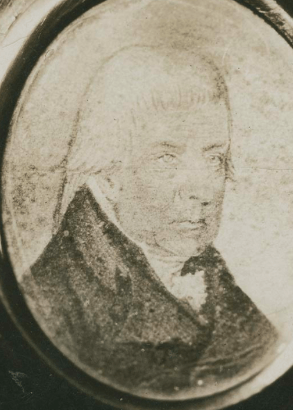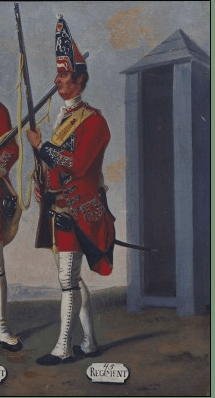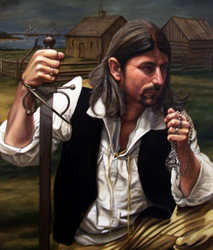Raid on Dartmouth (1751) facts for kids
Quick facts for kids Raid on Dartmouth |
|||||||
|---|---|---|---|---|---|---|---|
| Part of Father Le Loutre's War | |||||||
 John George Pyke, Only image of survivor of the Raid on Dartmouth (1751) |
|||||||
|
|||||||
| Belligerents | |||||||
| Mi'kmaq militia Acadian militia |
|||||||
| Commanders and leaders | |||||||
| Joseph Broussard (Beausoleil) | Captain William Clapham Lt. Clark, Warburton's Regiment (wounded) Sgt. ?, 45th Regiment † Superior officer ?, 45th Regiment † Captain Thomas Stannard (taken prisoner) |
||||||
| Strength | |||||||
| 60 Acadian and Mi'kmaq | 60 British regulars and rangers | ||||||
| Casualties and losses | |||||||
| disputed: Cornwallis: 6 Mi'kmaq Salusbury: one or two Mi'kmaq |
disputed: Cornwallis: 4 killed; 6 prisoners; Wilson's journal: 15 killed, 7 wounded (3 die in hospital), 6 prisoners; Salusbury journal: 20 killed; London Magazine: 8 settlers and a few officers killed, 14 prisoners |
||||||
The Raid on Dartmouth was a surprise attack during Father Le Loutre's War. It happened on May 13, 1751. A group of Miꞌkmaq and Acadian fighters, led by Joseph Broussard, attacked the British town of Dartmouth, Nova Scotia. They destroyed parts of the town and killed about twenty British settlers.
The town was defended by a fort called a blockhouse. British soldiers and rangers were stationed there. This raid was one of many attacks by the Mi'kmaq and Acadians on Dartmouth during the war.
Contents
Why the Raid Happened: Historical Background

After Britain took control of Acadia in 1710, they renamed it Nova Scotia. Most people living there were Catholic French Acadians and the Miꞌkmaq people. The Mi'kmaq had raided British settlements before, like Shelburne in 1715 and Canso in 1720. They later signed a peace treaty with the British in 1726.
Years later, Father Le Loutre's War began. This happened when Edward Cornwallis arrived in June 1749 to build the city of Halifax. The Wabanaki Confederacy, which included the Mi'kmaq, had a long history of fighting British settlers along the border between New England and Acadia.
Building New British Settlements
The British quickly started building more towns. To protect these new Protestant settlements from Mi'kmaq, Acadian, and French attacks, they built forts. These forts were in places like Halifax (1749), Bedford (1749), Dartmouth (1750), Lunenburg (1753), and Lawrencetown (1754). Many raids, like the Raid on Dartmouth in 1751, happened against these new villages.
Earlier Attacks on Dartmouth
There was an earlier attack on Dartmouth in 1749. After this, Governor Edward Cornwallis announced a plan to remove the Mi'kmaq from Nova Scotia and anyone who supported them. To do this, he created two companies of rangers, led by Captain Francis Bartelo and Captain William Clapham. These groups searched the area around Halifax for Mi'kmaq, but they were not successful.
In July 1750, the Mi'kmaq killed seven men working in Dartmouth. In August 1750, 353 new settlers arrived and started building the town of Dartmouth. The next month, on September 30, 1750, Dartmouth was attacked again. Five more residents were killed. In October 1750, a group of eight men went hunting and were captured by the Mi'kmaq. By March 1751, there had been six raids on Dartmouth in two years.
The 1751 Raid on Dartmouth
Three months later, on May 13, 1751, before sunrise, Joseph Broussard led sixty Miꞌkmaq and Acadians to attack Dartmouth once more. This event became known as the "Dartmouth Massacre." The attackers traveled down the Shuebenacadie River from Chignecto.
Broussard and his group killed twenty settlers and took others prisoner. Captain William Clapham and sixty soldiers were on duty in the blockhouse. They fired at the attackers from the fort, which was located on a hill overlooking Dartmouth Cove. The attackers injured some soldiers, including a sergeant.
Captain Alexander Murray and about 40 soldiers left Halifax in three boats to chase the attackers. However, most of the raiding party had already scattered. The British reported that they had killed six Mi'kmaq fighters. A group of settlers led by John Wisdom, who were camped at Dartmouth Cove, helped the other settlers. When they returned to their camp the next day, they found that the Mi'kmaq had also raided their camp and taken one of their men prisoner.
The British took the bodies of those killed to Halifax to be buried in the Old Burying Ground. John George Pyke survived the raid, but his father did not.
After the Attack
The British responded to the raid by sending armed groups to Chignecto. They killed some French defenders and broke the dikes, which are walls that hold back water. This ruined hundreds of acres of crops, causing big problems for the Acadians and French troops.
Right after the raid, a wooden fence, called a palisade, was built around Dartmouth. Mi'kmaq and Acadian attacks continued throughout the French and Indian War. This war ended fourteen years after Dartmouth was first settled. For example, in the spring of 1759, there was another attack on Fort Clarence, where five soldiers were killed.
After the 1751 raid, no new settlers were brought to Dartmouth for the next thirty years. Of the 383 settlers who arrived in Dartmouth in August 1750, only half remained two years later. By the end of the war in 1763, only 78 settlers were left in Dartmouth. Similar raids also happened when the British founded Lawrencetown and Lunenburg, Nova Scotia, such as the Raid on Lunenburg in 1756.




